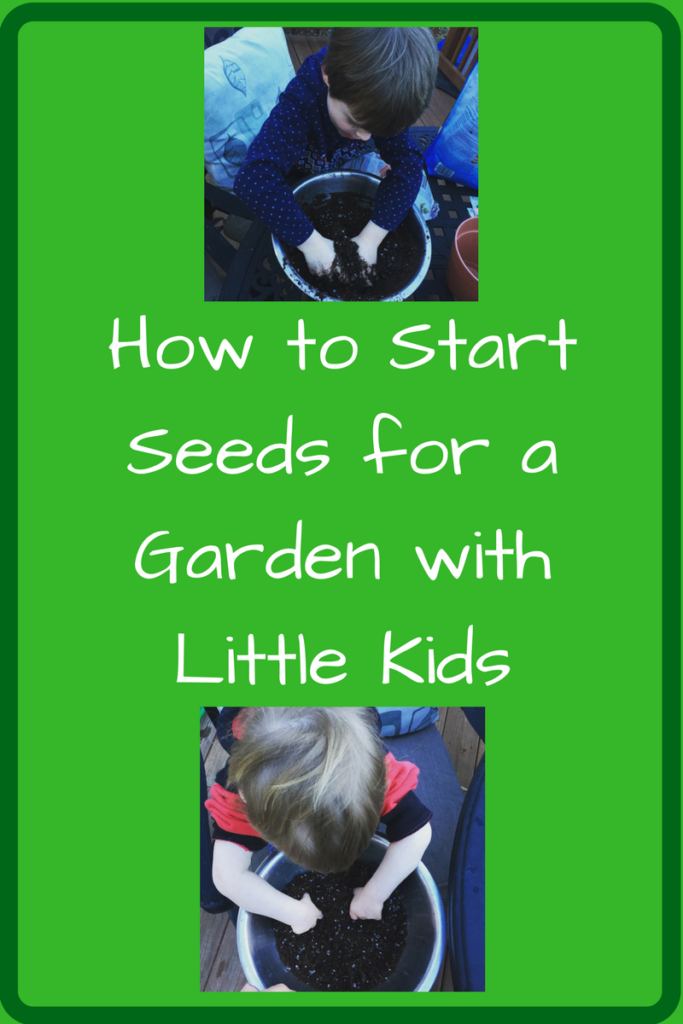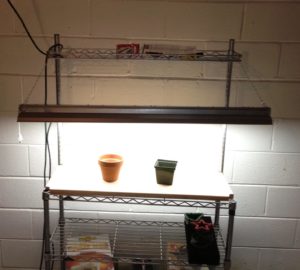Thinking about starting seeds for your family vegetable garden? Here’s step-by-step instructions on starting seeds and getting your kids involved.

Watching my kids plunge their hands into a mix of seed starting mix and water on our back deck, I know there’s something simply right about what we’re doing. And messy. Very messy.
But after planning a garden with kids, seed starting is the next logical step. While I could fill my backyard garden with seedlings from the farmers’ market, starting everything from seed is both cheaper and more rewarding. It helps the kids see the full life-cycle of plants, from seed to fruit and back to seed again. It’s also a great way to get them involved before spring shows up.
So every year, I flip through the Southern Exposure Seed Exchange catalog, order too much, and start the process of bringing up seedlings. (If you’re not in the Southeast U.S., Home for the Harvest has a great list of sustainable vegetable seed companies.) While my older son (nicknamed Sprout, appropriately) has helped start seeds the last few years, my younger son started helping this year too.
Here’s what we’ve learned:
Be Strategic About Starting Seeds
Not all seeds need to be started inside. Some should only be planted straight into the ground, like carrots. Others do well either way. As starting seeds and taking care of them indoors is a bit of a hassle, only select the plants that it’s really necessary for.
For us, we’ve had the most success starting tomatoes, basil, and peppers. Eggplant is another one you need to start inside before transplanting, but I’ve never had it grow well from seed myself.
Figure Out Your Timing
You want to make sure that you start seeds neither too early or too late. When you need to start your seeds depends both on the last average frost date for your area and what types of seeds you’re planting. You can start seeds that can withstand a little cold, like broccoli, early. Most of the time, they’ll do okay if you transplant them and the temperature drops. On the other hand, having a cold snap hit your tomato seedlings will equal the beginning and end of your tomato crop. Planting late starters like tomatoes too early can also lead to them getting too big in their pots before you transplant them. They can start falling over or not grow deep enough roots.
Thankfully, my weird timing often works out for the best. Many years, I’ve thought we were far behind, when we were actually right on time for tomatoes and basil. Like all things in parenting, planning to be ready way earlier than you need to be means that you’ll end up barely doing it on time.
Get Your Kids Excited!
If this isn’t your first time at this messy rodeo, it helps to remind your kids how fun gardening was the summer before. The first year we gardened with Sprout, he adored picking cherry tomatoes ripe off the vines and stuffing them in his mouth. He’d fill his little watering can from the rain barrel and dump it on his feet.
Having books on gardening – especially Up in the Soil and Down in the Dirt – that we read all winter helped him remember. When I told him the next year that we’d be starting seeds for the garden, he immediately understood the purpose.
Prepare Your Space
Before you get started, you need containers to plant your seeds in. Traditional terra cotta or even plastic ones are great if you have them on hand.
If you don’t, seed starting is a great way to recycle quart-sized yogurt containers. Punch holes in the bottom with a knife or screwdriver and you’re good to go. If they start to get brittle, throw them in the trash or recycling (if recycling that kind of plastic is available where you live).
You can buy planters made for seed starting from gardening stores, but I find they’re way too small. Once the seedlings get started, you have to transplant them into something bigger almost immediately. As I’m a klutz and transplanting stresses the plants out a lot, I just start with normal-sized pots.
Just like with human babies, baby plants need nice, clean conditions to live in. Sanitizing the planters helps keep away fungus and nasty bacteria that could infect the tiny plants. (Especially if your planters accumulate weird crud in the shed all winter like mine do.) In the past, I’ve sprayed them with a bleach solution and then rinsed them with water. This year, I went more natural. I sprayed vinegar on them, let them sit to dry, and then rinsed them out with water.
Get Your Mud Ready
Unlike planting seeds in the garden, you can’t start seeds inside with any old dirt. I highly recommend buying seed starting mix from the garden store. It should have just the right mix of nutrients and water-absorbing materials in it. (You can make your own, but it’s pretty complex.)
Once you have your containers and your mix, you’re ready to set the table for seed starting. This is where my advice is likely to diverge from pretty much everyone else’s.
Personally, I fill a big metal bowl with water and set it on our back deck. While you can do this inside if you have to, it has the potential to make a giant mess. If you can find a day that’s not hideously cold, it’s way better to do it outside. In addition to the bowl, I set up the pots and bag of seed starting mix on the table. I also pull chairs or step stools up to the table so the kids can reach it. Then, and only then, I retrieve the kids. I’ve done enough craft and cooking activities with them to realize having everything set up first is essential.
Then, I pour in the seed starting mix into the bowl of water and let them go to town. The first time my older son did it, he stuck his hand in to the bowl, pulled it out, looked at it, and asked, “Need towel?” I shook my head and said, “No, it’s supposed to be dirty.” I stuck my own hand in and squished it. “See?” He watched and then stuck his hands in, slowly realizing the lovely feeling of squishy mud. He didn’t ask for a towel again!
On the other hand, my younger son loved pushing the mud between his hands. His smile could power a small city.
Part of the reason I combine the water and seed starting mix this way is because I love watching my kids’ expressions. Playing in mud is the ultimate in kid-friendly activities.
From a gardening perspective, it has also some serious benefits. Seed starting mix is extremely loose and fine. Water tends to go right through it and puddle underneath. When you plant seeds in seed starting mix and then water them, the water creates little channels and holes, burying the seeds and drowning them. Making thick mud before planting thickens the mix enough to plant tiny seeds in. It also keeps them hydrated for the first day or so.
Plant Your Seeds
Once the seed starting mixture becomes nice and thick, it’s time to move it into the containers. Under my direction, the kids scoop up handfuls of mud and dump them in the flowerpots. Unless I tell them to stop, they’ll often keep adding dirt long past when the pots are full enough.
Once the pots are full, I ask each kid to stick his finger in and make a hole in the dirt. As they always make holes that are way too deep, I just brush a little dirt over it to fill it in.
Then, I shake the seeds into my hand and have them pinch them with their fingers to put in the pot. If I shake the seeds into their hands from the bag, they dump most of the seeds on the ground. I personally always plant way more seeds than we need. I’d rather pull a few extra seedlings out than not have enough sprout.
Grow Your Seeds
Garden catalogs want you to think seed starting set-ups must be extravagantly expensive, running hundreds of dollars or more. They don’t. Some people are lucky enough to be able to put their seeds under a gloriously sunny window and have them sprout to their hearts’ content. Others can build a cold frame and have them grow in there.

Unfortunately, neither of those approaches have worked well for us in the past. Instead, we built our own seed starting set-up with relatively cheap materials from Home Depot. We bought the cheapest grow light possible (similar to this one) and hung it off of an existing kitchen cabinet. We also purchased a heating mat to warm up the pots a little bit, considering our basement is a bit chilly. In general, anything that has a place to place the pots and a place to hang the lights will work fine.
Once the plants are in place, it’s my older son’s job to remind my husband to turn on the lights every day. In all honesty, we all try to remember. But the responsibility is good for him and makes him really feel involved.
Another great job for little kids is “pet” the plants. Gently patting the seedlings mimics a soft breeze and strengthens them. It’s also really cute!
Transplant Your Seeds into the Garden
Like kids, plants also don’t do well with abrupt transitions. Bringing them from the warm, cozy inside to the cold, damp outside can badly weaken little seedlings. While there are all sorts of elaborate ways to ease that transition, like cold frames, I just bring my plants outside for a couple hours a day for about a week before putting them in the ground. It’s just enough to get them used to the often chilly and windy Washington D.C. spring weather.
Honestly, starting seeds and preparing our garden in the fall are by far the most time-consuming parts of our gardening. There is absolutely nothing wrong with buying seedlings from the farmers’ market or a local garden store and being done with it. (In fact, I do that to fill in the garden when something I’ve planted inevitably fails.) At the same time, starting your own seeds provides a beautiful illustration of the full cycle of gardening.
The second year I started seeds with my older son, I told him, “You were a great helper. You’re going to be a great gardener.” Stepping down the concrete steps outside our house, he turned to me and said with pride, “[Sprout] is a gardener.” From starting seeds to harvesting, he’s definitely turned into one.
For more on gardening with kids, check out How to Create the Best Low-Maintenance Garden with Kids and How to Plan a Vegetable Garden with Your Kids. To discuss more green and sustainable living projects with your family, join our Green and Sustainable Parenting Group on Facebook!
Pingback: Sustainable Seed Starting — Practical Self Reliance
I loved planting seeds for a garden with our kids. It teaches them so many valuable lessons – hope, faith, patience, and work. What a great post!
Thanks!